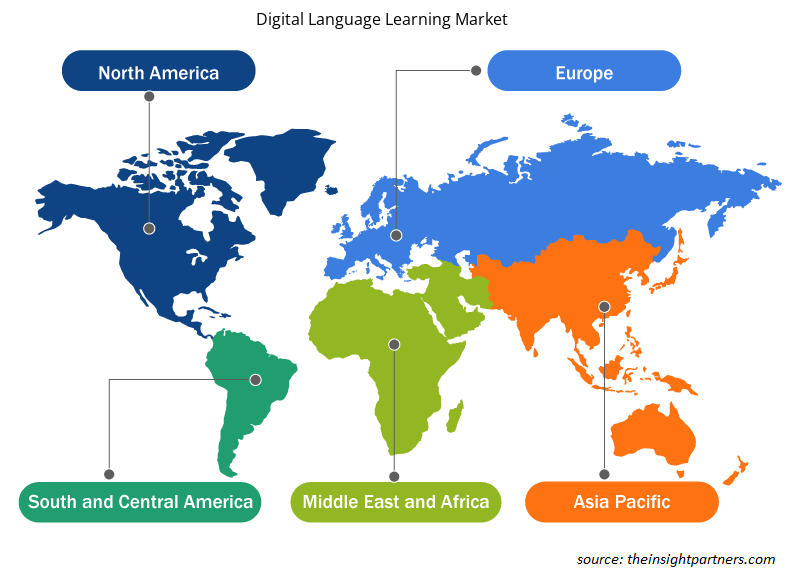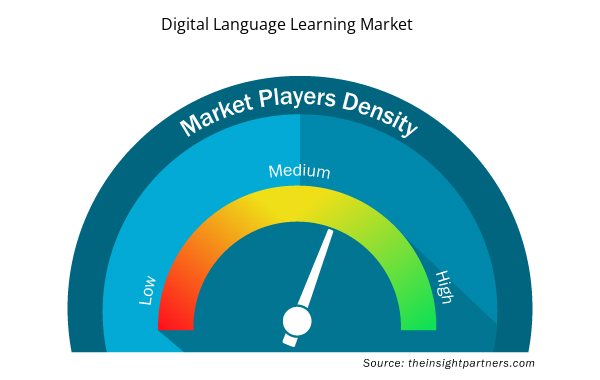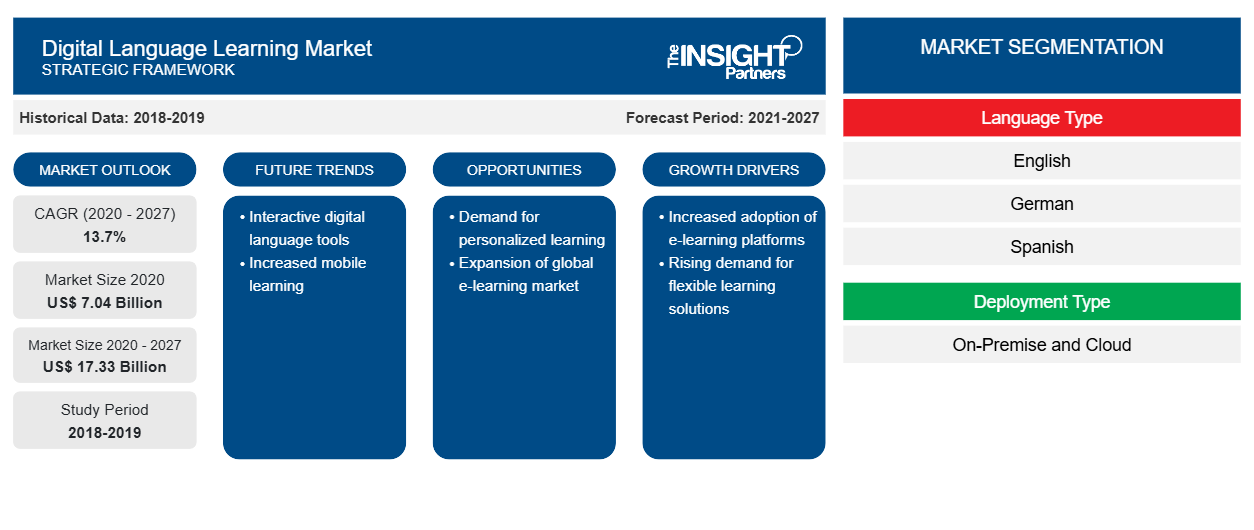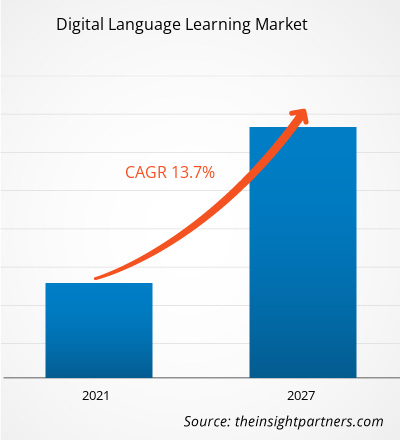デジタル言語学習市場は、2020年の70億3,820万米ドルから2027年までに1億7,333万米ドルに成長すると予想されており、2020年から2027年にかけて13.7%のCAGRで成長すると予測されています。
さまざまな政府による英語学習プログラム実施への取り組みが、市場の成長につながっています。世界の教育分野は、政府や民間組織がデジタル強化されたパフォーマンスを提供するために行っているさまざまな取り組みを背景に、飛躍的に変化しています。中国、オーストラリア、ブラジル、UAEなどのさまざまな国の政府は、過去数年間にデジタル教育スキームを開始しており、これらの国々が英語教育システムを強化するのに役立っています。たとえば、10年前に開始されたオーストラリア政府によるデジタル教育革命(DER)により、多くの学校や大学がデジタル教育を活用できるようになりました。同様に、中国政府も英語学習に重点を置いたデジタル教育を推進するためのいくつかの政策を開始しており、中国の学生にデジタル学習ソリューションを提供する企業の数が増加しています。51Talkは、中国で最も有名なデジタル英語学習機関の1つです。17Zuoyeは、中国の学生、教師、保護者向けの別のデジタルプラットフォームで、演習や宿題の形でオンライン課題を提供し、エンドユーザーが能力を強化できるようにしています。現在、インドはデジタル教育のための大きな市場スペースを創出すべく歩みを進めています。インド政府は、教育分野でデジタル化技術を普及させるために、さまざまな取り組みを行っています。SWAYAM は、インド政府が実施している最も著名なデジタル学習プラットフォームであり、学生が高等教育のすべての科目を網羅したオンライン コースを選択できるように支援する取り組みです。国際大学も、SWAYAM プラットフォームを通じてそれぞれのコースと試験を提供することが許可されており、学生は国際大学で学び、試験を選択できます。この要素により、学生の英語学習、会話、およびライティングのスキルが向上します。国立デジタル ライブラリは、インド政府が実施しているもう 1 つの取り組みで、ワンストップ ファシリティから仮想学習リソースを提供するというビジョンを持っています。この取り組みは徐々に注目を集めており、今後数年間でインドのデジタル英語学習市場の成長を促進し、それによって世界のデジタル言語学習市場の成長に貢献すると期待されています。
要件に合わせてレポートをカスタマイズする
このレポートの一部、国レベルの分析、Excelデータパックなど、あらゆるレポートを無料でカスタマイズできます。また、スタートアップや大学向けのお得なオファーや割引もご利用いただけます。
- このレポートの主要な市場動向を入手してください。この無料サンプルには、市場動向から見積もりや予測に至るまでのデータ分析が含まれます。
COVID-19パンデミックがデジタル言語学習市場に与える影響
最近のパンデミックの発生は、過去数か月間に世界中の既存の教育セクターにかなりのプラスの混乱をもたらしました。さらに、従来の教育機関と教室ベースの学習手法の混乱により、堅牢で効率的なオンラインおよびデジタル学習ソリューションの採用が急増し、今後数年間はパンデミック後も市場の成長を牽引し続けると予測されています。たとえば、ユネスコは、テクノロジー企業とITU(国際電気通信連合)のいくつかの主要代表者と協力して、新興経済国で物理的なインフラストラクチャに多額の投資をすることなく、より多くの聴衆が迅速な学習能力を実現できるようにするために、学習にデジタルテクノロジーを採用することの経済的重要性を強調しました。
一方、ケンブリッジ大学が実施した別の調査では、1,200人を超える回答者が、調査対象者の60%が今後数年間にデジタル学習テクノロジーを継続する傾向が高まっていることを確認しました。したがって、最近のパンデミックはデジタル学習テクノロジーの採用の急増を促進し、その後、過去数か月間の市場の成長にプラスの影響を与えました。
市場洞察 – デジタル言語学習市場
高度で簡素化されたテクノロジーを活用して学生をデジタル教育に引き付ける
米国や英国などの先進国では、学校、大学、その他の教育機関の学生がテクノロジーを完全に認識しているため、デジタル教育システムは非常に人気があります。しかし、APAC および SAM 諸国では、学生はテクノロジー主導の学習を認識していません。多くの学校、大学、コーチング機関が授業にデジタルテクノロジーを導入しています。デジタル教育プラットフォームの開発者は堅牢なソリューションを提供するためにテクノロジーを常にアップグレードしているため、APAC の採用者はテクノロジーインフラストラクチャを継続的にアップグレードしています。革新的なクラウドベースの教育アプリ、Web サイト、その他のサービスは、デジタル言語学習ソリューションを含むデジタル教育の大きな市場を生み出すと予想されています。
言語タイプに基づく洞察
言語の種類に基づいて、デジタル言語学習市場は英語、中国語、スペイン語、ドイツ語、その他に分類されます。2019年には英語セグメントが最大の市場シェアを占めました。
デジタル言語学習市場の地域別洞察
予測期間を通じてデジタル言語学習市場に影響を与える地域的な傾向と要因は、Insight Partners のアナリストによって徹底的に説明されています。このセクションでは、北米、ヨーロッパ、アジア太平洋、中東およびアフリカ、南米および中米にわたるデジタル言語学習市場のセグメントと地理についても説明します。

- デジタル言語学習市場の地域別データを入手
デジタル言語学習市場レポートの範囲
| レポート属性 | 詳細 |
|---|---|
| 2020年の市場規模 | 70.4億米ドル |
| 2027年までの市場規模 | 173.3億米ドル |
| 世界のCAGR(2020年 - 2027年) | 13.7% |
| 履歴データ | 2018-2019 |
| 予測期間 | 2021-2027 |
| 対象セグメント | 言語タイプ別
|
| 対象地域と国 | 北米
|
| 市場リーダーと主要企業プロフィール |
|
市場プレーヤーの密度:ビジネスダイナミクスへの影響を理解する
デジタル言語学習市場は、消費者の嗜好の変化、技術の進歩、製品の利点に対する認識の高まりなどの要因により、エンドユーザーの需要が高まり、急速に成長しています。需要が高まるにつれて、企業は提供内容を拡大し、消費者のニーズを満たすために革新を起こし、新たなトレンドを活用し、市場の成長をさらに促進しています。
市場プレーヤー密度とは、特定の市場または業界内で活動している企業または会社の分布を指します。これは、特定の市場スペースに、その市場規模または総市場価値に対してどれだけの競合相手 (市場プレーヤー) が存在するかを示します。
デジタル言語学習市場で活動している主要企業は次のとおりです。
- バベル
- 株式会社ブスー
- フルエンス
- リンゴダ株式会社
- リビング・ランゲージ(ペンギン・ランダムハウス、LLC)
免責事項:上記の企業は、特定の順序でランク付けされていません。

- デジタル言語学習市場のトップキープレーヤーの概要を入手
デジタル言語学習市場で活動する企業は、主に高度で効率的な製品の開発に重点を置いています。
- 2019年、Fluenzは、2020年春にスペインのバルセロナにスペインラグジュアリーイマージョンプログラムを拡大すると発表しました。ユーザーは言語学習のために6日間プログラムに参加できるようになります。
- 2018年、Preply, Inc.は2019年初頭にバルセロナに新オフィスを開設する計画を発表しました。この拡張は7月に400万ドルの資金調達によって実現しました。同社はさらに、ドイツ、イギリス、アメリカ、ラテンアメリカ市場でのプレゼンスを拡大する計画です。
デジタル言語学習市場は次のように分類されています。
世界のデジタル言語学習市場 - 言語タイプ別
- 英語
- ドイツ語
- スペイン語
- 中国語
- その他
世界のデジタル言語学習市場 - 展開タイプ別
- オンプレミス
- 雲
世界のデジタル言語学習市場 - 事業タイプ別
- 企業間取引
- 企業対顧客
世界のデジタル言語学習市場 - エンドユーザー別
- アカデミック
- 非学術的
世界のデジタル言語学習市場 – 地域別
- 北米
- 私たち
- カナダ
- メキシコ
- ヨーロッパ
- フランス
- ドイツ
- イタリア
- ロシア
- 英国
- その他のヨーロッパ
- アジア太平洋(APAC)
- 日本
- 中国
- オーストラリア
- インド
- 韓国
- その他のアジア太平洋地域
- 中東およびアフリカ(MEA)
- サウジアラビア
- アラブ首長国連邦
- 南アフリカ
- MEAの残り
- 南アメリカ(SAM)
- ブラジル
- アルゼンチン
- 残りのSAM
デジタル言語学習市場 – 企業プロファイル
- バベル
- 株式会社ブスー
- フルエンス
- リンゴダ株式会社
- リビング・ランゲージ(ペンギン・ランダムハウス、LLC)
- ピアソンPLC
- プレプライ株式会社
- ロゼッタストーン株式会社
- 株式会社バーブリング
- ヤブラ株式会社
- 過去2年間の分析、基準年、CAGRによる予測(7年間)
- PEST分析とSWOT分析
- 市場規模価値/数量 - 世界、地域、国
- 業界と競争環境
- Excel データセット



Report Coverage
Revenue forecast, Company Analysis, Industry landscape, Growth factors, and Trends

Segment Covered
This text is related
to segments covered.

Regional Scope
North America, Europe, Asia Pacific, Middle East & Africa, South & Central America

Country Scope
This text is related
to country scope.
よくある質問
APAC region led digital language learning market. APAC comprises countries with developed educational sectors, including China, Australia, India, Singapore, and South Korea. These countries are leveraging every possible method and model to enhance English proficiency with an aim to increase the number of English speaking individuals. According to EF Education First English Proficiency Test, Asian countries hold the second position, after Europe, among the non-native English speaking countries. Over the years, countries in APAC have been investing significantly in promoting English language learning and also has lucrative opportunities for English learning.
Increasing number of Asian students migrating to western countries is the major factor driving the growth of the market. Digital English language learning is witnessing the major demand from the both academic and non-academic sectors in Asian countries. The currently increasing trend among Asian students to enroll themselves in universities in the western countries for higher education is creating a significant demand for language learning courses. Majority of the candidates from Asian countries, especially from India and China, enroll themselves for Test of English as a Foreign Language (TOEFL), International English Language Testing System (IELTS), Graduate Record Examination (GRE), Test of English for International Communication (TOEIC), and other language-based courses and certifications. TOEFL and IELTS are the tests conducted to assess a non-native candidate’s English fluency level, including proper English speaking and writing skills. This factor compels the enrolling candidates to opt for English Language Training (ELT) institutes. The burgeoning demand for these competitive exams has led to the establishment of various ELT institutions across these countries, which in turn has opened up avenues for different English learning methods.
English is the most preferred language in terms of business perspectives across the globe, and close to 30 nations worldwide have it as their primary language of communication. More than 20% of the global population speaks this language. As a result, various sectors around the world have given importance to English as a common language for communications. Further, on the back of the trending globalization, many businesses have been set in different parts of the world where English is a mandatory language for communication. Digital English language learning encompasses digital content and products that facilitate easy learning through the use of various ICT-enabled interactive tools. These tools include mobile applications, e-books, audio clips, videos, games, digital software, and online tutoring, among others. A few of the key companies operating in the digital English language learning market are Cambridge University Press, Cengage/ National Geographic Learning, and EF Education First
Trends and growth analysis reports related to Technology, Media and Telecommunications : READ MORE..
The List of Companies - Digital Language Learning Market
- Babbel
- Busuu Ltd
- Fluenz
- Lingoda GmbH
- Living Language (Penguin Random House, LLC)
- Pearson PLC
- Preply, Inc
- Rosetta Stone, Inc.
- Verbling, Inc
- Vabla, Inc
The Insight Partners performs research in 4 major stages: Data Collection & Secondary Research, Primary Research, Data Analysis and Data Triangulation & Final Review.
- Data Collection and Secondary Research:
As a market research and consulting firm operating from a decade, we have published and advised several client across the globe. First step for any study will start with an assessment of currently available data and insights from existing reports. Further, historical and current market information is collected from Investor Presentations, Annual Reports, SEC Filings, etc., and other information related to company’s performance and market positioning are gathered from Paid Databases (Factiva, Hoovers, and Reuters) and various other publications available in public domain.
Several associations trade associates, technical forums, institutes, societies and organization are accessed to gain technical as well as market related insights through their publications such as research papers, blogs and press releases related to the studies are referred to get cues about the market. Further, white papers, journals, magazines, and other news articles published in last 3 years are scrutinized and analyzed to understand the current market trends.
- Primary Research:
The primarily interview analysis comprise of data obtained from industry participants interview and answers to survey questions gathered by in-house primary team.
For primary research, interviews are conducted with industry experts/CEOs/Marketing Managers/VPs/Subject Matter Experts from both demand and supply side to get a 360-degree view of the market. The primary team conducts several interviews based on the complexity of the markets to understand the various market trends and dynamics which makes research more credible and precise.
A typical research interview fulfils the following functions:
- Provides first-hand information on the market size, market trends, growth trends, competitive landscape, and outlook
- Validates and strengthens in-house secondary research findings
- Develops the analysis team’s expertise and market understanding
Primary research involves email interactions and telephone interviews for each market, category, segment, and sub-segment across geographies. The participants who typically take part in such a process include, but are not limited to:
- Industry participants: VPs, business development managers, market intelligence managers and national sales managers
- Outside experts: Valuation experts, research analysts and key opinion leaders specializing in the electronics and semiconductor industry.
Below is the breakup of our primary respondents by company, designation, and region:

Once we receive the confirmation from primary research sources or primary respondents, we finalize the base year market estimation and forecast the data as per the macroeconomic and microeconomic factors assessed during data collection.
- Data Analysis:
Once data is validated through both secondary as well as primary respondents, we finalize the market estimations by hypothesis formulation and factor analysis at regional and country level.
- Macro-Economic Factor Analysis:
We analyse macroeconomic indicators such the gross domestic product (GDP), increase in the demand for goods and services across industries, technological advancement, regional economic growth, governmental policies, the influence of COVID-19, PEST analysis, and other aspects. This analysis aids in setting benchmarks for various nations/regions and approximating market splits. Additionally, the general trend of the aforementioned components aid in determining the market's development possibilities.
- Country Level Data:
Various factors that are especially aligned to the country are taken into account to determine the market size for a certain area and country, including the presence of vendors, such as headquarters and offices, the country's GDP, demand patterns, and industry growth. To comprehend the market dynamics for the nation, a number of growth variables, inhibitors, application areas, and current market trends are researched. The aforementioned elements aid in determining the country's overall market's growth potential.
- Company Profile:
The “Table of Contents” is formulated by listing and analyzing more than 25 - 30 companies operating in the market ecosystem across geographies. However, we profile only 10 companies as a standard practice in our syndicate reports. These 10 companies comprise leading, emerging, and regional players. Nonetheless, our analysis is not restricted to the 10 listed companies, we also analyze other companies present in the market to develop a holistic view and understand the prevailing trends. The “Company Profiles” section in the report covers key facts, business description, products & services, financial information, SWOT analysis, and key developments. The financial information presented is extracted from the annual reports and official documents of the publicly listed companies. Upon collecting the information for the sections of respective companies, we verify them via various primary sources and then compile the data in respective company profiles. The company level information helps us in deriving the base number as well as in forecasting the market size.
- Developing Base Number:
Aggregation of sales statistics (2020-2022) and macro-economic factor, and other secondary and primary research insights are utilized to arrive at base number and related market shares for 2022. The data gaps are identified in this step and relevant market data is analyzed, collected from paid primary interviews or databases. On finalizing the base year market size, forecasts are developed on the basis of macro-economic, industry and market growth factors and company level analysis.
- Data Triangulation and Final Review:
The market findings and base year market size calculations are validated from supply as well as demand side. Demand side validations are based on macro-economic factor analysis and benchmarks for respective regions and countries. In case of supply side validations, revenues of major companies are estimated (in case not available) based on industry benchmark, approximate number of employees, product portfolio, and primary interviews revenues are gathered. Further revenue from target product/service segment is assessed to avoid overshooting of market statistics. In case of heavy deviations between supply and demand side values, all thes steps are repeated to achieve synchronization.
We follow an iterative model, wherein we share our research findings with Subject Matter Experts (SME’s) and Key Opinion Leaders (KOLs) until consensus view of the market is not formulated – this model negates any drastic deviation in the opinions of experts. Only validated and universally acceptable research findings are quoted in our reports.
We have important check points that we use to validate our research findings – which we call – data triangulation, where we validate the information, we generate from secondary sources with primary interviews and then we re-validate with our internal data bases and Subject matter experts. This comprehensive model enables us to deliver high quality, reliable data in shortest possible time.


 このレポートの無料サンプルを入手する
このレポートの無料サンプルを入手する